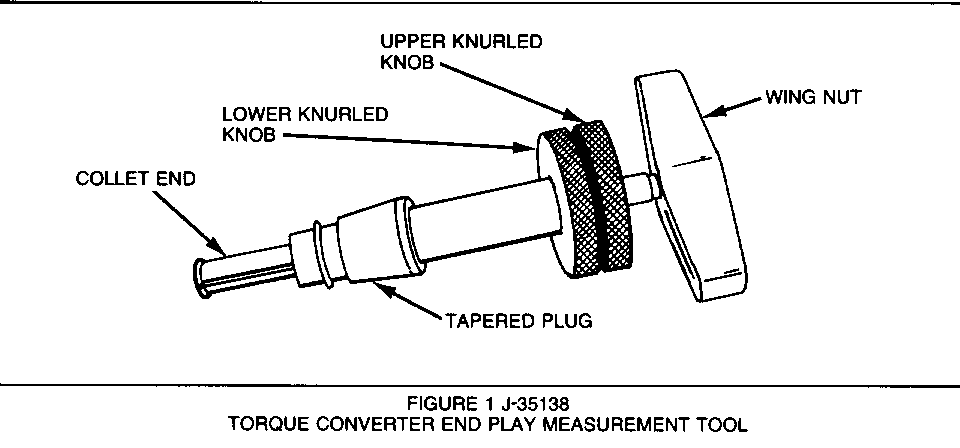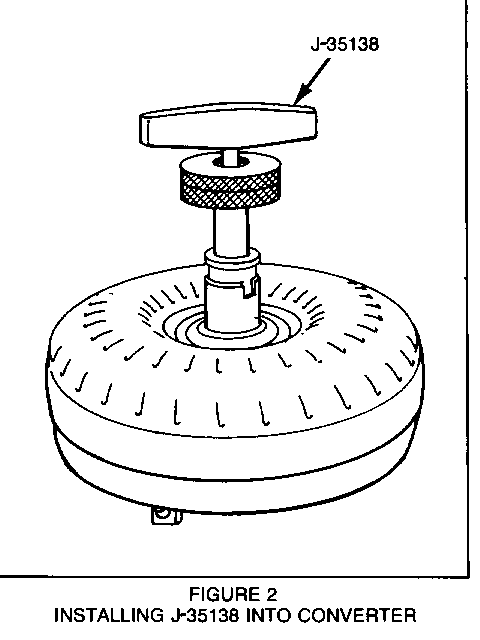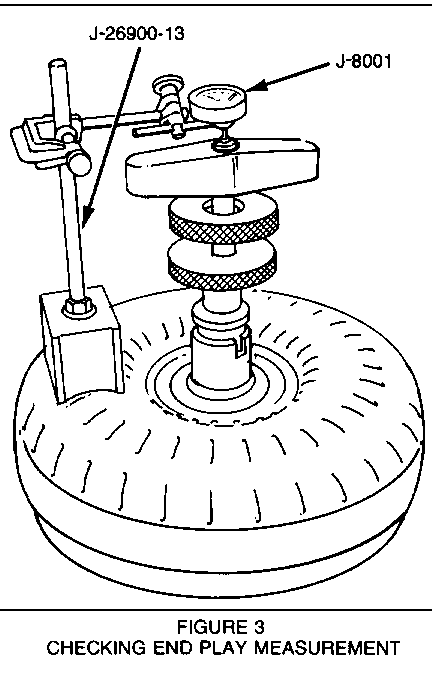TORQUE CONVERTER END PLAY NEW MEASUREMENT TOOL

MODELS/YEARS: ALL MODELS
A new essential Torque Converter End Play Measurement tool, Kent-Moore number J-35138 has been developed and will be shipped to Oldsmobile dealers approximately May 1985. Refer to Figure 1. This new universal tool replaces the previously released End Play Measurement tools, Kent-Moore numbers J-28538, J-25020-02, J-29060, J-21371 and J-29830.
Using J-35138, end play measurement on all torque converters is performed as follows:
1. Screw upper and lower knurled knobs together. Be sure collet end is not expanded. Refer to Figure 1.
2. Insert J-35138 into the torque converter hub. Refer to Figure 2.
3. Slide tapered plug into torque converter hub. Plug is for alignment of tool.
4. Hold upper knurled knob and turn wing nut clockwise until hand tight to expand collet into converter turbine hub. Then loosen wing nut (counterclockwise) 2 1/2 turns, or until tool is loose (will move up and down) while not removeable from converter.
5. Hold upper knurled knob and turn lower knurled knob clockwise until hand tight to clamp tool in the converter turbine hub.
6. Attach magnetic base (J-26900-13) to torque converter and set up dial indicator (J-8001) so that indicator tip is in center of tool wing nut. Refer to Figure 3.
7. To make end play check, push upper knurled knob down, zero out dial indicator and pull lower knurled knob up. Be sure tapered plug stays seated in converter hub. End play is the difference between up and down positions. DO NOT ALLOW WING NUT TO TURN WHEN MEASURING.
8. Remove tool by holding upper knurled knob and turning wing nut counterclockwise.
Refer to the following chart for torque converter end play specifications. Torque converters that exceed the maximum end play specifications should be replaced.
Size (Approximate End Play Style Outside Diameter) Specifications
Torque Converter 245 mm 0 - 0.50 mm Clutch (T.C.C.) (10 inches) (0 - 0.019")
298 mm 0 - 0.60 mm (12 inches) (0 - 0.023")
Open Converter All Sizes 0 - 1.30 mm (Non-T.C.C.) (0 - 0.050")



General Motors bulletins are intended for use by professional technicians, not a "do-it-yourselfer". They are written to inform those technicians of conditions that may occur on some vehicles, or to provide information that could assist in the proper service of a vehicle. Properly trained technicians have the equipment, tools, safety instructions and know-how to do a job properly and safely. If a condition is described, do not assume that the bulletin applies to your vehicle, or that your vehicle will have that condition. See a General Motors dealer servicing your brand of General Motors vehicle for information on whether your vehicle may benefit from the information.
